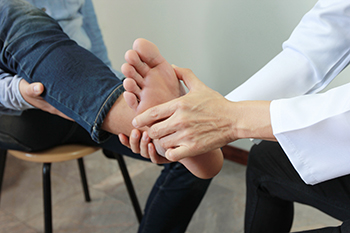How to prevent diabetic foot problems
November 28, 2018

NCH Medical Group Podiatrist Neal Shukla, DPM, AACFAS answers questions about one of the most vulnerable parts of the body: the feet. Dr. Shukla performs surgery at Northwest Community Hospital (NCH) and sees patients with diabetes at 1450 Busch Parkway in Buffalo Grove, 500 N. Hicks Road in Palatine and at the NCH Wound Center.
Why are the feet vulnerable in patients with diabetes?
Feet are one of the most neglected body parts. We don’t check our feet on a regular basis. Patients may not notice redness, swelling, calluses that may be lesions/ulcers or even infection until it becomes severe. Usually when patients with diabetes visit the podiatrist, it’s because they have a problem they may think is minor but actually it could be something major or a sign of other underlying issues.
What is peripheral neuropathy?
Peripheral neuropathy is damage to the peripheral nerves. These nerves have been damaged from the diabetes so they may not function properly. Patients have a decreased sensation in their fingers and toes. From there, they develop problems from these body parts.
How is it diagnosed?
We examine patients and test these neuropathic sensations. We perform monofilament, vibratory tests and at times take blood to evaluate blood sugars. Higher blood sugar in a diabetic increases the chance of developing neuropathy. About 60 to 70 percent of patients with diabetes will have peripheral neuropathy in their lifetime.
How often should patients with diabetes see a podiatrist?
I would say at least twice a year. If they need a referral, they can get one from their primary care physician.
What are some common complications that can happen to the feet?
Ulcerations are one of the first signs of complications from diabetes, and these often are seen in the emergency room. Sometimes a patient with a foot ulceration could be an undiagnosed diabetic.
Some patients can get third-degree burns because they can’t feel the heat of the pavement or the heat of the sand on the beach. They’ve lost the gift of pain, of knowing what’s wrong.
How often should diabetic patients check their feet?
I tell my patients to check their feet in the morning when they wake up and when they go to bed. When they’re putting their shoes and socks on, they should check their feet and check the insides of their shoes for any debris that could cause harm. A simple thing like a small pebble that they can’t feel can cause a problem. They might be working throughout the day and then later see some sort of bloody drainage from a wound that they created because they didn’t realize it was there.
What are other risk factors for peripheral neuropathy?
Risk factors may include, but are not limited to, poor circulation/vascular disease, smoking, eating habits/obesity as well as having a family history of diabetes, ulcers and/or amputations.
What treatments are performed for foot wounds?
We have a whole arsenal of treatments, from topical agents to donated human tissue. Wound vacs, or vacuum-assisted closure, can help as well, depending on a patient’s circulation. If there’s pus, we’ll take cultures and place the patient on the appropriate antibiotic.
What are some symptoms to be looking for when checking the feet?
Any cut, wound or lesion on the foot should prompt a patient to come in because it could become something major or it could represent an underlying issue. Corns and calluses can give an indication of pressure issues which can be preulcerative types of lesions. I also recommend checking for any unusual redness, swelling or odor than could indicate signs of infection.
How common are amputations among patients with diabetes?
Unfortunately, they are very common. We do our best to save the toe or limb but sometimes the damage has been done. For diabetics, amputation can vary from the pinky toe, to half of the foot, to a below-the-knee amputation. It depends on the infection, which can spread easily. Diabetics may step on something and since they’re immunocompromised, they can pick up many different types of bacteria thus prompting them to be on multiple types of antibiotics. For patients who have an amputation, about 50 percent of them will have another one within the next five years.
What can be done to prevent problems with the feet?
There are diabetic shoes that prevent friction and lower foot pressure. Seeing a podiatrist regularly can reduce the risk of amputation by about 80 percent. Check your feet multiple times a day. It never hurts to be overly cautious. Exercising regularly helps with glucose control, circulation and overall well-being. Walking is probably the best form of exercise you can do. It’s free and you can do it anywhere. I have patients who walk inside malls for the warmth and unlimited track. Plus, it’s free and it doesn’t hurt to window shop. Some of my patients belong to the NCH Wellness Center as well. Having the right lifestyle is very important.
Do you prescribe shoes and socks?
We can prescribe diabetic shoes and socks. A podiatrist can perform an assessment and write a prescription so that patients can see an orthotist and/or prosthetist who can fabricate/design different types of diabetic shoes. Patients can get properly fitted, and sometimes a mold of their feet can be made for a more customized pair of shoes. If the patient had a previous amputation, a toe or foot filler can be made. It’s important to have properly fitted shoes to reduce chances of complications to the diabetic foot.
Diabetic socks are available as well. Some are compressive, some are not. The main thing is the inner lining and moisture-wicking qualities that can reduce blisters and other types of issues.
Coordinated care
Dr. Shukla works hand in hand with primary care physicians, ophthalmologists, endocrinologists, infectious disease specialists, vascular surgeons and neurologists to provide coordinated care for patients with diabetes. For more information or to schedule an appointment, call 847-725-8401.